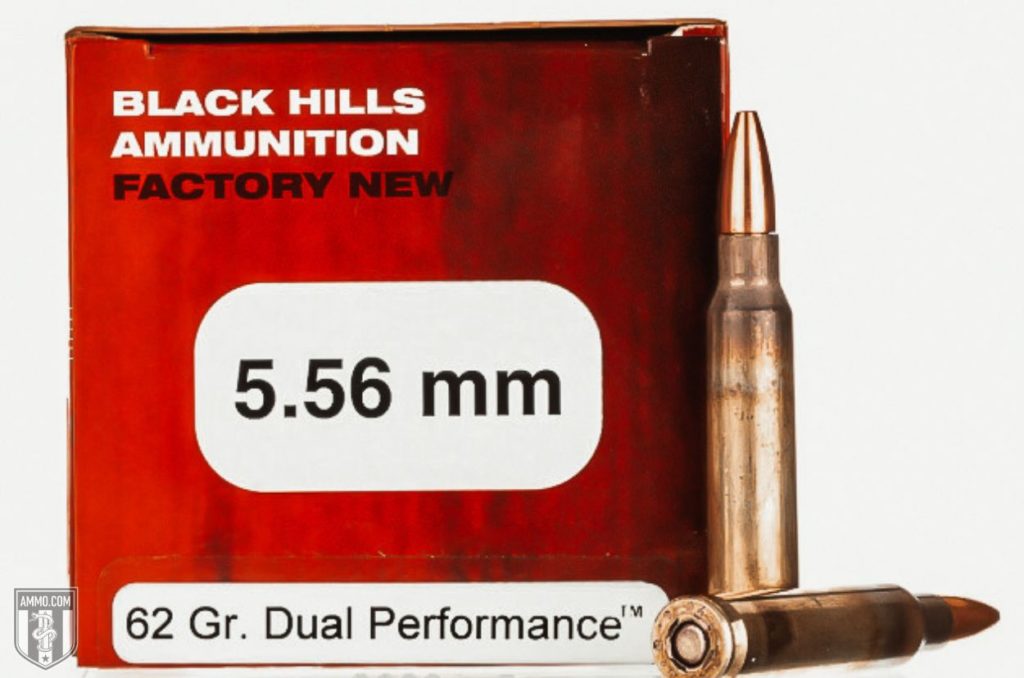If you’re looking for the best 5.56 NATO ammo on the market, then you’ve come to the right place! With so many different varieties of 5.56 ammo available from multiple retailers, it can be hard to know what’s best for home defense.
In this article, we are going to share with you our top 5 picks for the best 5.56 NATO home defense ammo available right now.
If you simply cannot wait, the best 5.56 ammo for home defense AR-15 rifle is Black Hills 62 gr Dual Purpose. But if you want to see the full list just keep scrolling and we’ll cover all our choices and explain why we picked them.
If you’re new to the 5.56x45mm NATO round, make sure to check out the Buyers Guide by clicking HERE.
Now let’s get to our top 5 picks for the best types of ammo for your 5.56 rifle…
Top 5 Best 5.56 Loads for Personal Defense
1) Black Hills 62 gr Dual Purpose
4) American Eagle XM193 55 gr FMJBT
5) Speer Gold Dot 75 gr JSP
Black Hills Dual Performance 62 Grain TSX
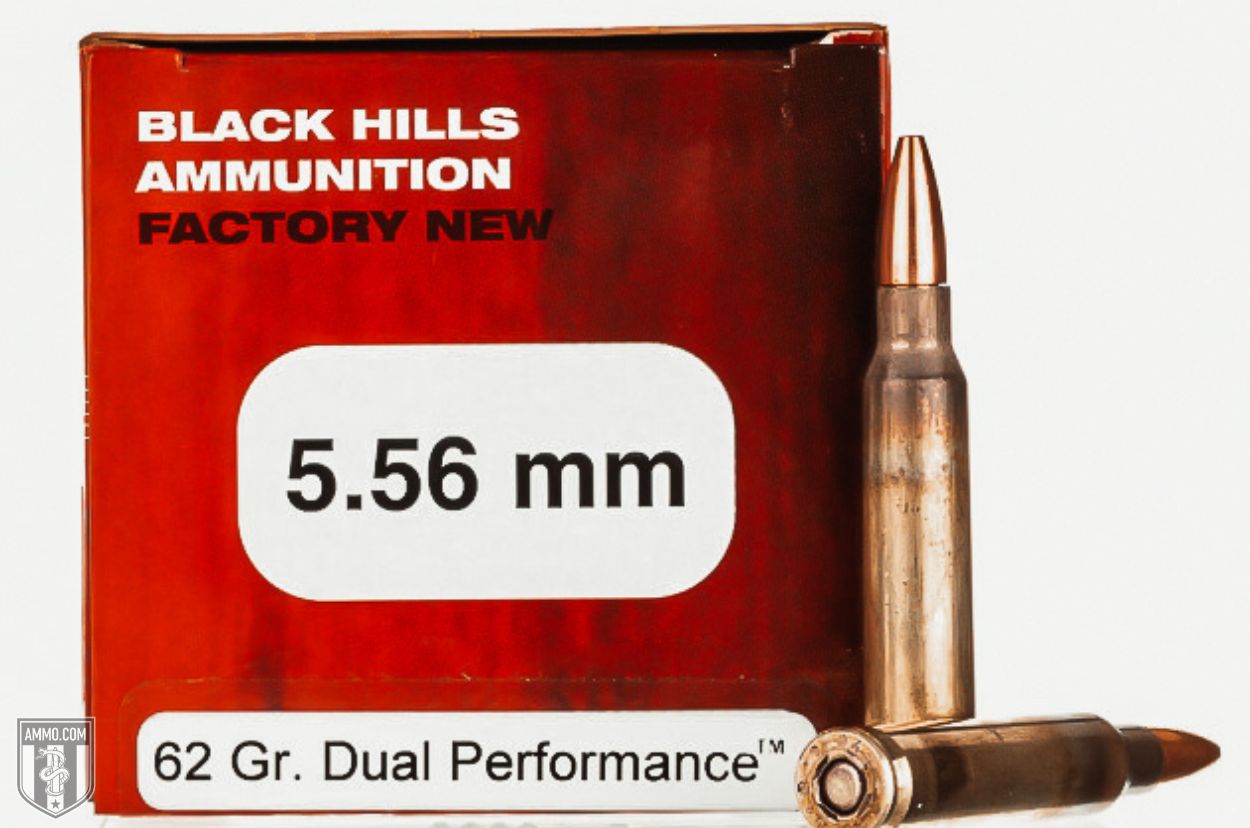
Specs:
- Bullet Style: Solid Copper Hollow Point (SCHP)
- Bullet Weight: 62 Grain
- Casing Type: Brass
- Muzzle Velocity: 3000 FPS
- Muzzle Energy: 1239 FT LBS
Pros:
- Match-grade quality
- Meets expansion requirements
- Readily available
Cons:
- Not the best choice for long range shots
Why We Chose It
Most gun owners can agree that Black Hills is always a top choice. They deliver match-grade accuracy and consistency at a price point that everyone can afford.
One major benefit is that the 62 gr Dual Purpose round is perfect for short-barreled rifles that measure 16” or less. This ammo isn’t great for long-range shots, but that’s just more appealing for home defense.
The Dual Performance hollow point is designed to expand immediately when it encounters soft tissue. This reduces the potential for over-penetration, which is a big concern when using a rifle for home defense over a handgun or shotgun.
To put it simply, the Black Hills Dual Performance checks all the boxes for the best all-around home defense 5.56 round.
Hornady Black 62 Grain
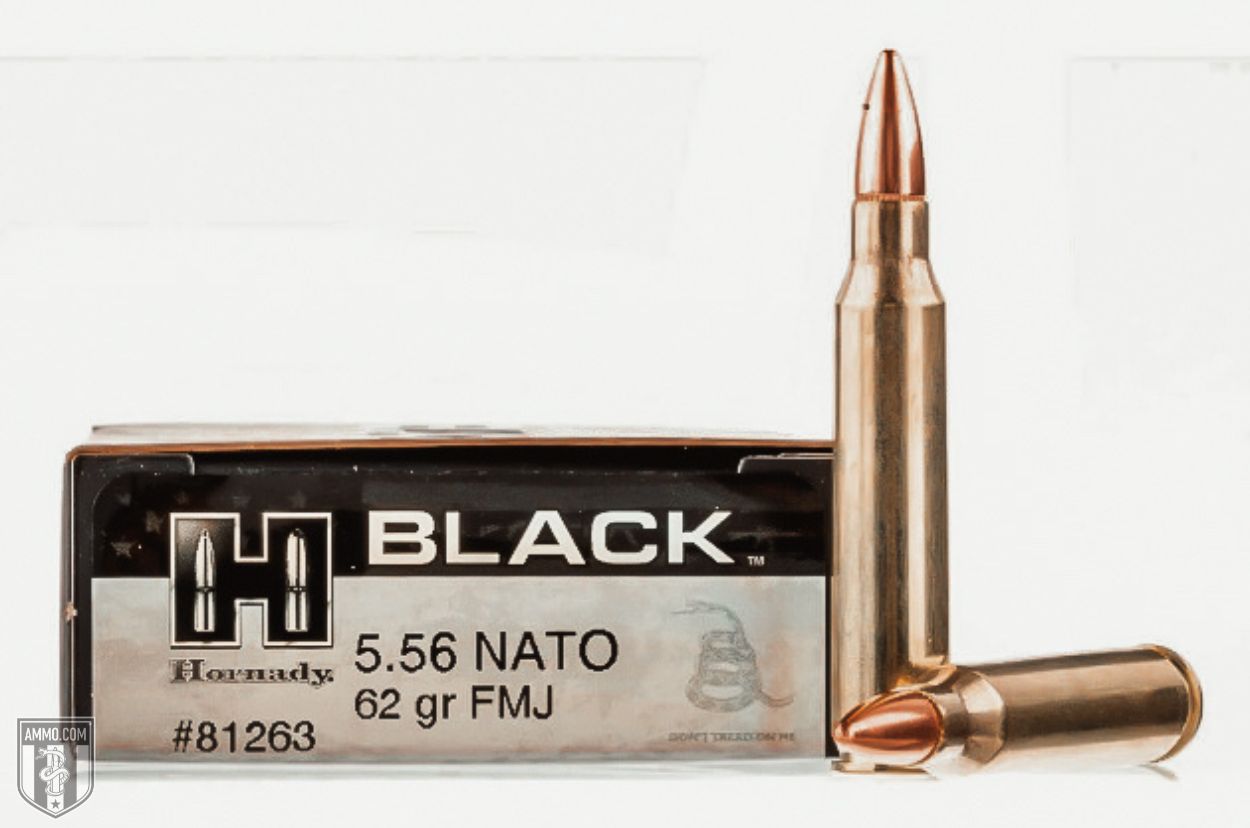
Specs:
- Bullet Style: Full Metal Jacket (FMJ)
- Bullet Weight: 62 Grain
- Casing Type: Brass
- Muzzle Velocity: 3060 FPS
- Muzzle Energy: 1289 FT LBS
Pros:
- Works with short and long-barrel rifles
- Reduced risk of over-penetration
- A true home defense round
- Works well with many commonly used off-the-shelf rifles
Cons:
- A bit pricey compared to other options
Why We Chose It
Hornady is another top-rated home defense round. But the Hornady Black 62gr stands above many others. Of the many great things about the Hornady Black FMJ is a versatile round that works well in both long and short-barreled rifles.
It should be noted that Hornady Black FMJs are NOT penetrator rounds with a mild steel core like SS109 (aka Green Tip) NATO mil-spec ammo. Instead, Hornady went with a soft lead core to promote tumbling and cavitation to minimize over-penetration.
In our hands, Hornady Black ammo was extremely accurate in every rifle we fired it in.
With supreme accuracy and superior bullet design, the Hornady Black 62 gr FMJ makes for an extremely potent home defense ammo.
Federal Champion 55 gr JSP
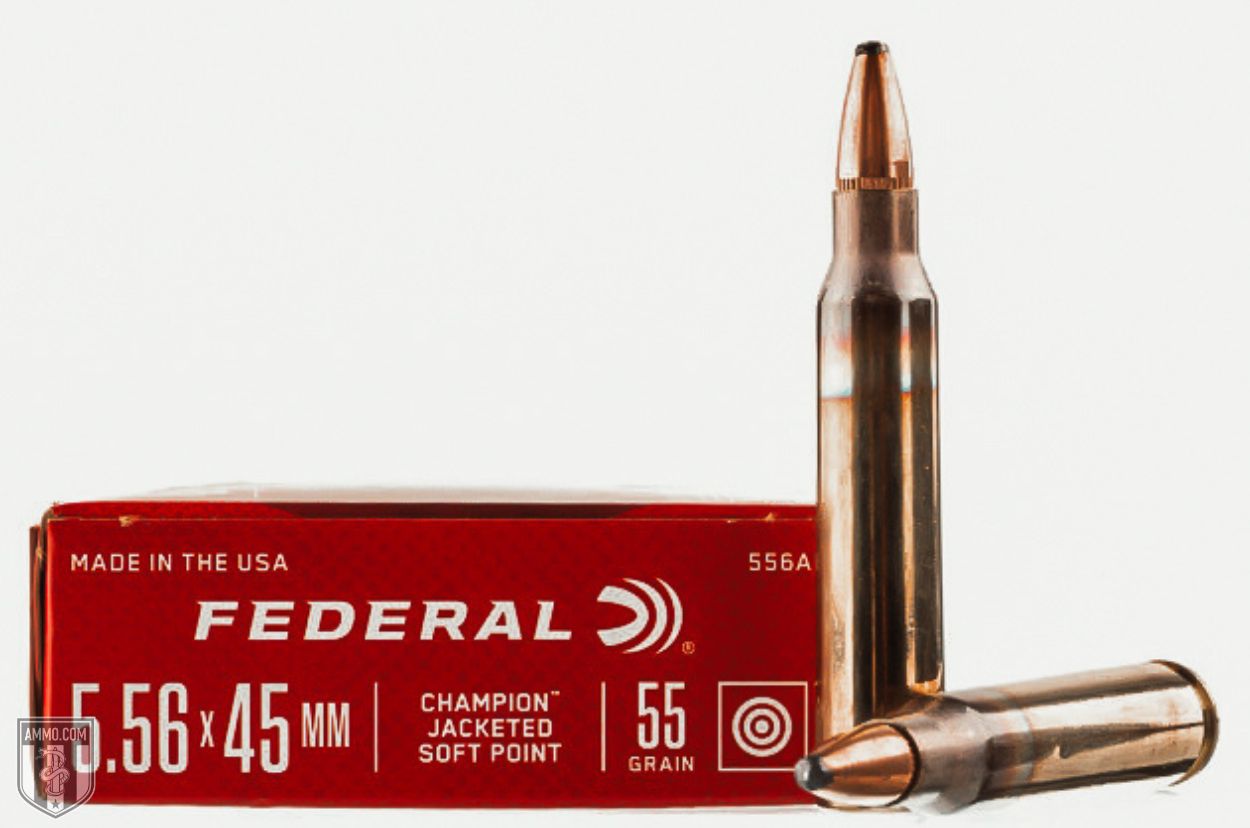
Specs:
- Bullet Style: Jacketed Soft Point (JSP)
- Bullet Weight: 55 Grain
- Casing Type: Brass
- Muzzle Velocity: 3000 fps
- Muzzle Energy: 1099 ft-lbs
Pros:
- Rapid expansion soft point
- Reduced risk of over-penetration
- Inexpensive
Cons:
- Not great for long-range shots
Why We Chose It
Federal Champion 55 gr jacketed soft point ammo makes an excellent choice for dispatching four-legged and two-legged varmints.
Utilizing the classic soft point design that mushrooms when it impacts soft tissue, this ammo has excellent terminal ballistics while minimizing over-penetration.
The only downside to traditional JSP ammo is that it’s not as aerodynamic as say a 77 gr Sierra Matchking or Barnes OTM (open tip match) bullet.
However, unless you live in a multi-million dollar mansion with 200+ meter long hallways, this ammo should be more than accurate enough for home defense.
American Eagle XM193 55 gr FMJBT
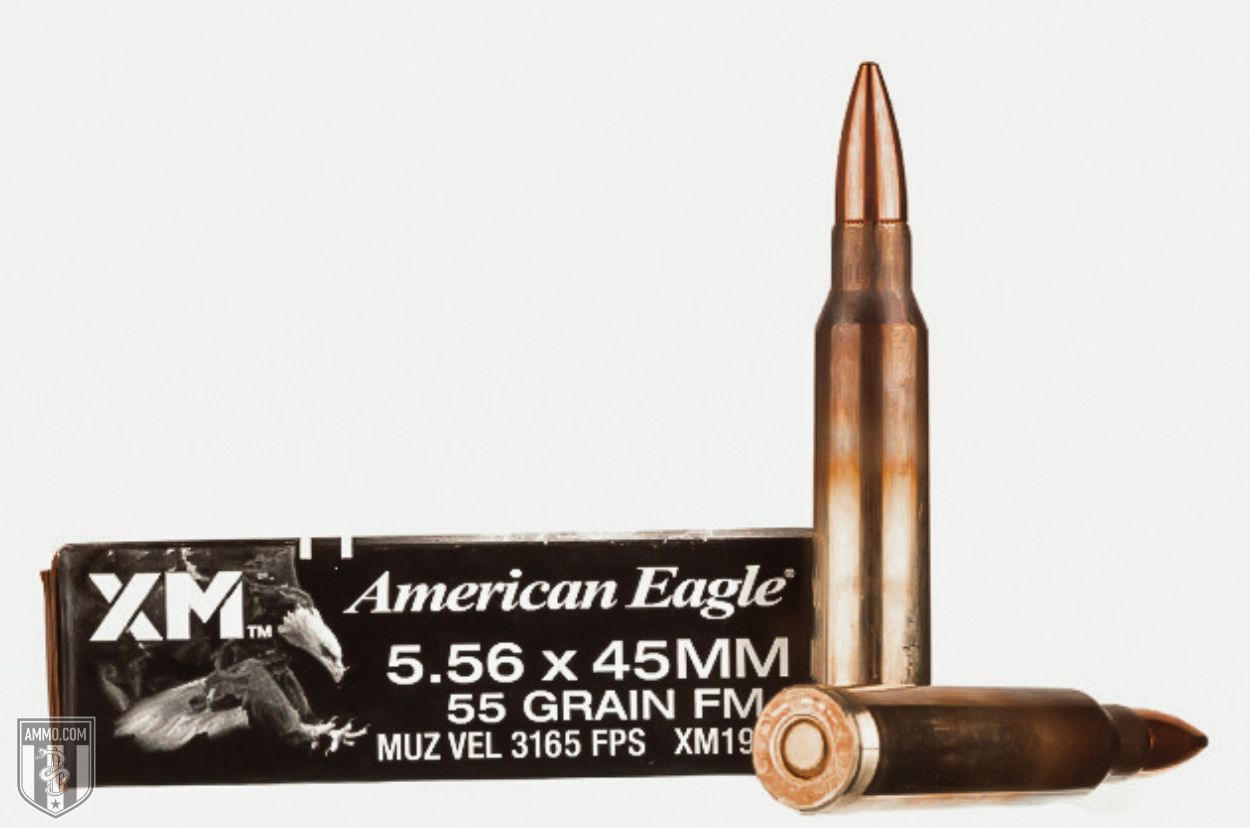
Specs:
- Bullet Style: Full metal jacket (FMJ)
- Bullet Weight: 55 Grain
- Casing Type: Brass
- Muzzle Velocity: 3165 fps
- Muzzle Energy: 1223 ft-lbs
Pros:
- Mil-Spec ammo
- Enough velocity to cause cavitation
- Inexpensive
Cons:
- Risk for over-penetration
Why We Chose It
If you want a true to form mil-spec copy of the military’s M193 ammo, then you need to grab some American Eagle XM193 55 gr FMJBT.
Developed around the original 223 Remington ammunition for the M16, the 55 grain full metal jacket boat tail (FMJBT) is traveling so fast that it will destabilize, or cavitate, when it encounters soft tissue. This cavitation often leads to the bullet breaking into multiple pieces which causes additional damage.
It may not be the fanciest hollow point design, but these 55gr FMJ bullets will get the job done. The only downside is that there is the potential for over-penetration.
However, if you need some budget-friendly ammo for target shooting, plinking, and home defense, you simply cannot beat Federal American Eagle XM193 ammo.
Speer Gold Dot 75 gr JSP
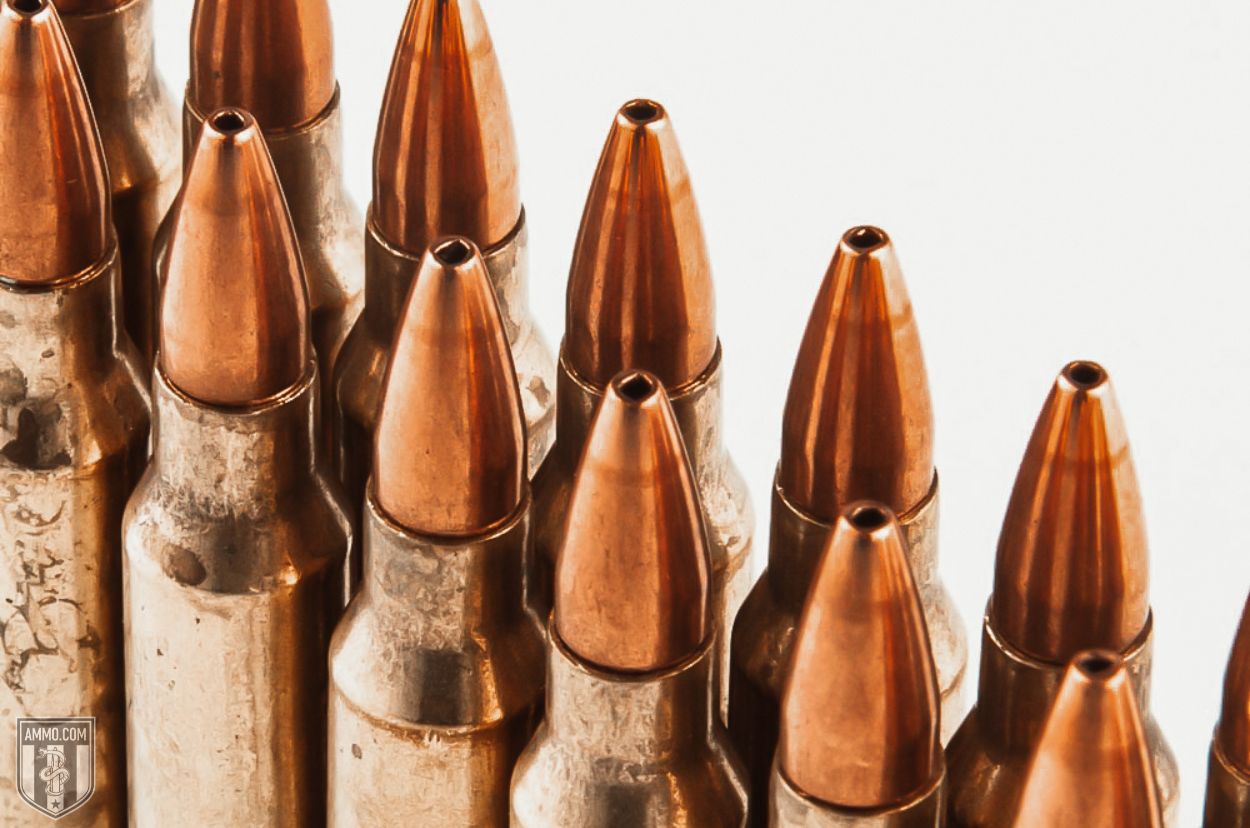
Specs:
- Bullet Style: Jacketed Soft Point (JSP)
- Bullet Weight: 75 Grain
- Casing Type: Nickel-Plated Brass
- Muzzle Velocity: 2775 fps
- Muzzle Energy: 1282 ft-lbs
Pros:
- Immediate expansion
- Heavy bullet weight
- Extremely reliable
Cons:
- Hard to find
Why We Chose It
If you’re looking for the biggest, badest, hardest hitting round on the market, then reach for the familiar gold box of Speer Gold Dot 75 gr JSP ammo.
Trusted by law enforcement for decades, Speer Gold Dot soft points are designed to expand the moment they counter tissue. This limits over penetration while causing extreme amounts of damage inside the bad guy.
Firing a massive 75 grain bullet, these Gold Dot rounds hit hard and are sure to stop any would-be home invader or attacker.
Speer took it up a notch when they loaded these rounds in nickel-plated brass cases to minimize malfunctions and ensure your self-defense carbine feeds smoothly when you need it the most.
I’m sure you’re wondering why this is the best AR-15 ammo on the market? Well, it pretty much is, but the problem is that it’s incredibly hard to find and a little pricey. However, if you can find a box or two of this, make sure you snatch it up because I promise you won’t be disappointed!
We’ve Got Your 5.56
As any ammo enthusiast will surely tell you, the cartridge you favor is subjective. But now you know what to consider before landing on the best 5.56 ammo for your home defense.
When you know your rifle and ammo, you’re more likely to produce the best outcome in a very bad situation. For us, that’s the Hornady and Black Hills 5.56 rounds. You aren’t likely to find a higher quality, more reliable home defense round than those.
5.56 Buyer’s Guide
Welcome to the 5.56 NATO buyer’s guide. No matter if you’re new to the 5.56 or a seasoned pro, it’s always good to know more about your favorite centerfire round.
In this guide we will explain why the 5.56 NATO is a great choice for home defense and exactly what you should be looking for in a personal defense round.
But first off, we need to address the elephant in the room…
5.56 NATO vs 223 Remington: What’s the Difference?
There’s a lot of confusion about this issue with new gun owners so we want to clear things up.
Some shooters think these rounds are the same, but they are actually two distinct types of ammo. Here’s the short answer:
5.56 NATO ammo is loaded to higher pressures than 223 Remington. Therefore, you can safely fire 223 Rem from a firearm chambered in 5.56 but you should NOT fire 5.56 from a 223 Rem rifle.
Here’s the long answer!
During the Vietnam War, the United States military adopted a new battle rifle, the M16, which fired the 223 Remington. The M16, and more recently the shortened M4 carbine, have been our primary battle rifles ever since.
The 223 ammo carried by our soldiers in Vietnam fired a 55 grain FMJ bullet and the cartridge was named M193.
Then in the 1980’s, NATO and the CIP decided to adopt the 223 Rem as their standardized battle cartridge as well. However, in an attempt to increase the round’s stopping power, they designed the round to fire at higher pressures.
The new round fired a 62 grain penetrator bullet with a mild steel core and was designated SS109 for NATO and M855 for the US military.
Although the 223 Rem and 5.56 are dimensionally identical, they are loaded to different pressures (55,000 vs 62,000 psi).
This is not to say that if you fire a 5.56 round from your 223 Remington rifle, you’ve just created a hand grenade. However, over time it can cause damage to the rifle and you may experience a critical failure at some point.
I don’t know about you, but guns are expensive and the last thing I want is to damage one of my expensive rifles!
To remedy this issue, gunsmith Bill Wylde introduced what is known as the 223 Wylde chamber. This is a chamber that can fire both 223 Rem and 5.56 NATO safely.
This can be really confusing for new shooters. Here’s the rundown again just for clarity.
- 5.56 NATO chamber – can fire 5.56 and 223 ammo safely
- 223 Wylde chamber – can fire 5.56 and 223 ammo safely
- 223 Remington chamber – can fire 223 ammo safely but NOT 5.56
Hopefully that cleared up the differences in rifle chambers as well as ammo names. Let’s move onto why 5.56 ammo is a great choice for home defense.
Why the 5.56 for Home Defense?
Contrary to popular belief, the 5.56 is an all-around excellent home defense round. Whereas shotguns and handguns are notorious for misplaced shots, excessive recoil, and overpenetration, the 5.56 reduces the likelihood of all these risks.
Another great benefit of a 5.56-chambered rifle is that you have plenty of rounds to fire in case of a home intruder scenario. Even if an unskilled shooter is left to defend themselves, low-recoil and increased magazine size come to save the day.
When we think of 5.56 ammo, we think of the AR-15 (ArmaLite Rifle). The lightweight rifle didn’t make the cut for the military (over the M14), so Colt bought the design, reimagined it, and designed it for civilian use.
While ArmaLite was testing the perfect combat rifle, NATO (North American Treaty Organization) was looking for better ammo. The .222 was a bit too heavy for our soldiers in combat after WWII. So, Remington created the 223 Remington (223 Rem for short). A powerful round that weighed less than 7.62mm, and offered less recoil, the .223 became an international favorite. Eventually, NATO adopted the 5.56×45 for its lighter weight, compact size, and lethality.
So, why would we consider ammunition originally intended for the battlefield for home defense? Well, the answer is simple. Civilians also benefit from the lightweight, low-recoil round that leaves a larger wound cavity.
Finally, the 5.56 is often revered for home defense because any home defense firearm will likely lead to overpenetration. But, the AR-15 chambered in 5.56, and other similar rifles are less likely to do as much damage as a handgun or shotgun based on several studies
Key Considerations for 5.56 Home Defense Ammo
Sure, hunting, target practice, and even plinking are necessary pastimes for the gun enthusiast. However, the home defense scenario is unique. You likely won’t find another purpose for your rifle more important than protecting your family. So, not every 5.56 ammo is best for home defense, but don’t worry, we’ll tell you why.
You must consider many factors before choosing your go-to home defense rounds. Perhaps, you’re already thinking about overpenetration and stopping power, but there’s even more to consider. So, let’s give you some things to think about before ordering your next box of 5.56 ammo.
Expansion Control
For those unfamiliar, expansion affects wound size and, therefore, stopping power. In a home defense scenario, we have two main goals; put the intruder down quickly and without hurting anyone else.
The more your projectile expands in its target, the less damage behind it and the larger the wound size. One key factor of expansion is the muzzle velocity (you can find this information on your ammo box or the manufacturer’s website).
Expansion control means we need to consider the relationship between velocity and material. Whereas a softer projectile such as lead or copper reaches its maximum expansion at 1,600 FPS (feet per second), a harder projectile will reach its maximum expansion at around 2,000 FPS.
Regardless of the projectile’s composition, it will reach full expansion in the first target it hits within a few inches. This gives us some leeway in projectile choice because some states limit the bullet’s design, while others are more costly and difficult to acquire.
Before we land on the absolute best 5.56 rounds for home defense scenarios, we should look at the cartridge’s muzzle velocity and composition (lead, copper, FMJ, JHP, etc.).
Penetration
Of course, we need to consider penetration. Penetration is the effectiveness of the ammo. The shape of the projectile, velocity, material, and weight affect penetration. Effective ammunition puts the threat down without causing unnecessary damage to the home or its inhabitants.
Perhaps you’re looking for a cartridge that reduces overpenetration. Let’s ease your concerns about that first. You’re more likely to miss your target than hit it and an innocent person behind it.
Following the “know your target and what’s beyond it” rule, you’re more likely to misplace your shot with a handgun or blow a hole in the wall with a shotgun. So consider that your 5.56 ammo can maximize penetration without putting others at risk as long as you’re confident in your target.
Essentially, it’s important to understand that no matter the round, you can control overpenetration (or, at least, when you take the shot and what’s in its path). What you can’t control is under penetration if you choose the wrong 5.56 ammo.
Along with all of that, the FBI standard for penetration is 12″-15″ inches. But that’s using ballistic gel. Home defense means we’ll be working with more barriers (bones, tissue, etc.). So, a varmint round that travels through 9″ of ballistic gel isn’t going to give us the wound size necessary to stop a threat. We need something with a bit more penetration power.
Your Rifle
We also need to consider your rifle. Well, not just your rifle, but how your rifle impacts the 5.56 ammo you choose.
Most off-the-shelf 5.56 rifles, like the AR-15, the Ruger American Ranch, Sig Sauer MDX, and the Mini-14, all have a twist rate of 1:7-1:8. This means your 5.56 round will rotate one time for every X inches of barrel length.
How does this play into home defense? Well, your twist rate can destabilize your round affecting the accuracy of the hit. While this probably isn’t a big deal in close quarters, it’s a good idea to consider your projectile’s weight (55gr, 62gr, 70gr, etc.).
Another consideration we’d like to point out is the casing material. Although it may not seem like an important factor in home defense ammo, the casing’s material can affect quality and function.
Steel casings are often cheaper but can lead to barrel corrosion and they jam more often than brass casings. Brass is easier on your barrel and more reliable. Of course, if you don’t reload your rounds and clean your rifle regularly, you can minimize the drawbacks of steel 5.56 ammo and save some money.
Reliability & Availability
Lastly, let’s explore the best 5.56 ammo for home defense in terms of function and reliability. Not all rounds are created the same. Your Black Hills rounds are individually inspected before ever leaving the facility. Hornady, however, caught a bad rap for a massive recall on the Frontier rounds when they were first released (the issue was resolved, and we have nothing negative to report today). But it’s a good idea to look at the quality and recalls before deciding on your rounds.
Next, we have to consider which rounds are more likely to be in stock and whether they’re suitable for home defense.
Of course, you’re likely to find the M193 or M855 in stock anywhere, but the rounds are often unpredictable, and you won’t see the expansion we need for home defense. It’s great ammo to stockpile for an apocalyptic scenario but not so great for everyday home defense.
Another hurdle we face with reliability and availability is that most bulk 5.56 ammo is only FMJs. FMJ rounds are better for long-range target practice, but we won’t need our projectile to travel more than a few yards in this scenario.
If all you have is FMJ ammo, we suggest knowing your target and what’s behind it because it will check our penetration boxes, but it may travel a little further than you’re comfortable with.
Now that you have a better understanding of the 5.56 NATO round, let’s get back to the Top 5 home defense rounds by clicking HERE.
The Best 5.56 Ammo for Home Defense originally appeared in The Resistance Library at Ammo.com.
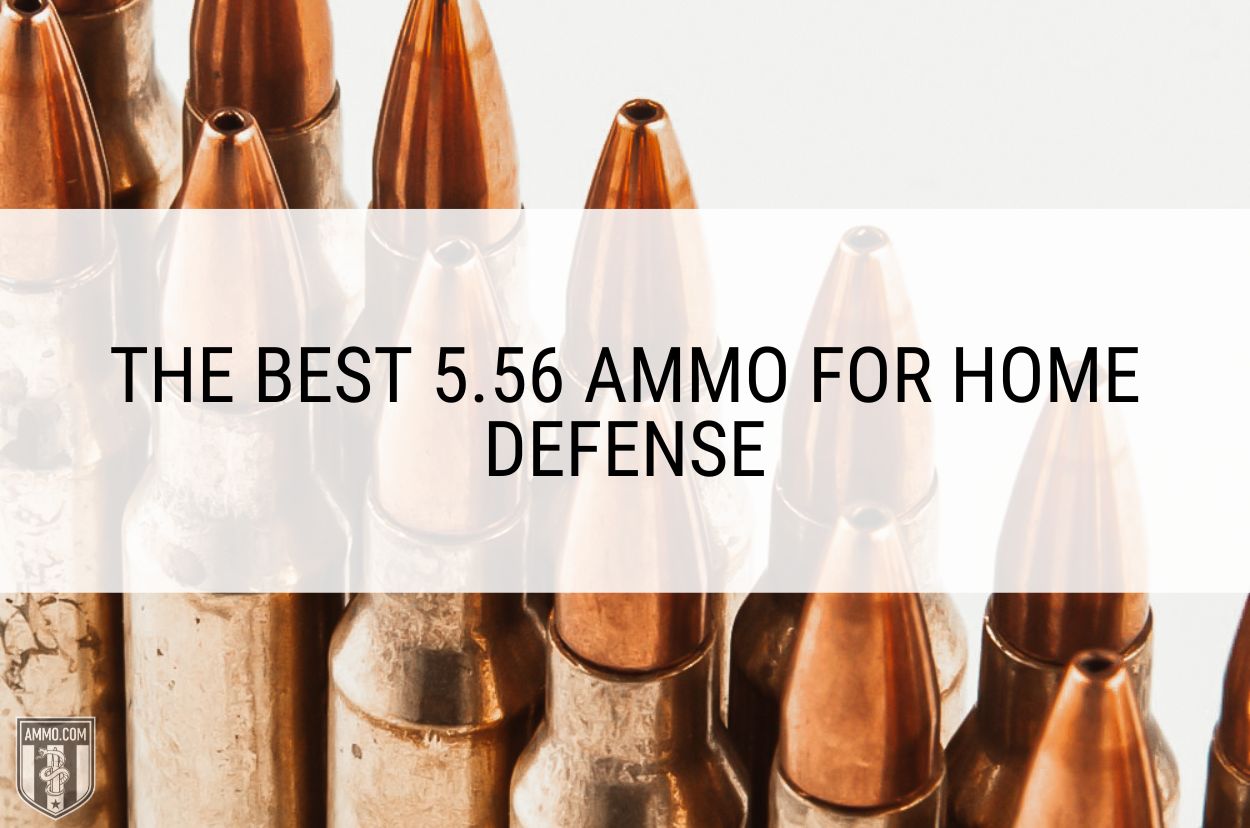
Source: The Daily Bell Rephrased By: InfoArmed
